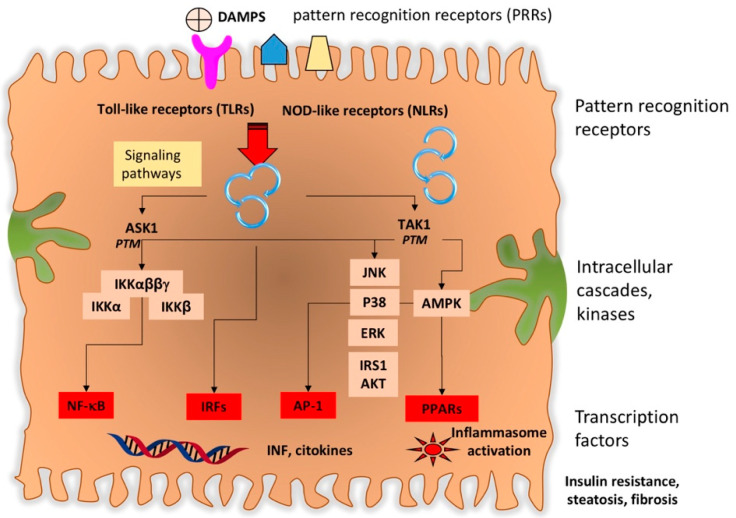Figure 4.
Detailed picture representing the ultimate consequence of circulating damage-associated molecular patterns (DAMs) on hepatocytes. DAMs represent the continuous stimulus for at least three intracellular events in the hepatocyte: (1) response of pattern recognition receptors (PRRs) such as Toll-like receptors (TLRs) and NOD-like receptors (NLRs). (2) Activation of intracellular cascades, kinases representing the downstream signaling pathways, such as the apoptosis signal-regulating kinase 1 (ASK1) and TGF-b-activated kinase 1 (TAK1). Both kinases are activated through post-transcriptional modification (PTM) and activate other key kinases (C-Jun N-terminal kinase, JNK), AMP-activated kinase, AMPK, and IkB). (3) Activation of transcription factors such as interferon regulatory factors (IRFs), nuclear factor (NF)-kB, activator protein 1 (AP-1), and peroxisome proliferator-activated receptors (PPARs). This ultimate event leads to the production of inflammatory cytokines and chemokines, with all metabolic consequences observed in NAFLD (insulin resistance, steatohepatitis, fibrogenesis, etc.). Additional endogenous targets regulating the innate immune elements in NASH include CASP8 and FADD-like apoptosis regulator (CFLAR), tumor necrosis factor (TNF) a-induced protein 3 (TNFAIP3), cylindromatosis (CYLD), transmembrane BAX inhibitor motif-containing 1 (TMBIM1), TNF receptor-associated factor 6 (TRAF6), TRAF1, TRAF3, dual-specificity phosphatase 14 (DUSP14), tripartite motif 8 (TRIM8), dickkopf-3 (DKK3), and TRAF5 (See also [41]).

